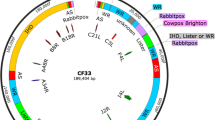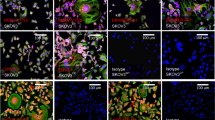Abstract
The human herpes virus 8 (HHV-8)-encoded G protein-coupled chemokine receptor (vGPCR) has been implicated in the pathogenesis of Kaposi's sarcoma (KS), particularly because of its high constitutive signaling activity. Here, we used retroviral transduction to generate vGPCR-expressing 3T3 fibroblasts that are tumorigenic in nude mice, but as expected fail to induce tumors in their immunocompetent counterparts. However, tumor fragments obtained from nude mice grow progressively in immunocompetent BALB/c mice. Unexpectedly, vGPCR-expressing cells established from grafted tumor fragments gave rise to tumors in immunocompetent mice. These tumors exhibit a striking histological resemblance to KS including plump spindle cell morphology, a high degree of vascularization and brisk mitotic activity. High expression of vGPCR was confirmed in the cell lines and tumors using a newly developed vGPCR-specific monoclonal antibody. Finally, short interfering RNA directed at vGPCR abrogated or significantly delayed tumorigenesis in mice, demonstrating that the tumor development is specifically driven by vGPCR. This novel model for vGPCR-mediated oncogenesis will contribute to our understanding of the role of vGPCR in the pathogenesis of HHV-8 and may even be important in identifying critical molecular and epigenetic changes during tumor progression in vivo.
This is a preview of subscription content, access via your institution
Access options
Subscribe to this journal
Receive 50 print issues and online access
$259.00 per year
only $5.18 per issue
Buy this article
- Purchase on Springer Link
- Instant access to full article PDF
Prices may be subject to local taxes which are calculated during checkout






Similar content being viewed by others
References
Akula SM, Naranatt PP, Walia NS, Wang FZ, Fegley B, Chandran B . (2003). Kaposi's sarcoma-associated herpesvirus (human herpesvirus 8) infection of human fibroblast cells occurs through endocytosis. J Virol 77: 7978–7990.
Arvanitakis L, Geras-Raaka E, Varma A, Gershengorn MC, Cesarman E . (1997). Human herpesvirus KSHV encodes a constitutively active G-protein-coupled receptor linked to cell proliferation. Nature 385: 347–350.
Bais C, Santomasso B, Coso O, Arvanitakis L, Raaka EG, Gutkind JS et al. (1998). G-protein-coupled receptor of Kaposi's sarcoma-associated herpesvirus is a viral oncogene and angiogenesis activator. Nature 391: 86–89.
Bais C, Van Geelen A, Eroles P, Mutlu A, Chiozzini C, Dias S et al. (2003). Kaposi's sarcoma associated herpesvirus G protein-coupled receptor immortalizes human endothelial cells by activation of the VEGF receptor-2/ KDR. Cancer Cell 3: 131–143.
Brekken RA, Thorpe PE . (2001). VEGF–VEGF receptor complexes as markers of tumor vascular endothelium. J Control Release 74: 173–181.
Cerimele F, Curreli F, Ely S, Friedman-Kien AE, Cesarman E, Flore O . (2001). Kaposi's sarcoma-associated herpesvirus can productively infect primary human keratinocytes and alter their growth properties. J Virol 75: 2435–2443.
Cesarman E, Mesri EA, Gershengorn MC . (2000). Viral G protein-coupled receptor and Kaposi's sarcoma: a model of paracrine neoplasia? J Exp Med 191: 417–422.
Chang Y, Cesarman E, Pessin MS, Lee F, Culpepper J, Knowles DM et al. (1994). Identification of herpesvirus-like DNA sequences in AIDS-associated Kaposi's sarcoma. Science 266: 1865–1869.
Chiou CJ, Poole LJ, Kim PS, Ciufo DM, Cannon JS, ap Rhys CM et al. (2002). Patterns of gene expression and a transactivation function exhibited by the vGCR (ORF74) chemokine receptor protein of Kaposi's sarcoma-associated herpesvirus. J Virol 76: 3421–3439.
Emrich T, Förster R, Lipp M . (1993). Topological characterization of the lymphoid-specific seven transmembrane receptor BLR1 by epitope-tagging and high level expression. Biochem Biophys Res Commun 197: 214–220.
Flore O, Rafii S, Ely S, O'Leary JJ, Hyjek EM, Cesarman E . (1998). Transformation of primary human endothelial cells by Kaposi's sarcoma-associated herpesvirus. Nature 394: 588–592.
Förster R, Kremmer E, Schubel A, Breitfeld D, Kleinschmidt A, Nerl C et al. (1998). Intracellular and surface expression of the HIV-1 coreceptor CXCR4/fusin on various leukocyte subsets: rapid internalization and recycling upon activation. J Immunol 160: 1522–1531.
Gallo RC . (1998). The enigmas of Kaposi's sarcoma. Science 282: 1837–1839.
Gershengorn MC, Geras-Raaka E, Varma A, Clark-Lewis I . (1998). Chemokines activate Kaposi's sarcoma-associated herpesvirus G protein-coupled receptor in mammalian cells in culture. J Clin Invest 102: 1469–1472.
Guo HG, Sadowska M, Reid W, Tschachler E, Hayward G, Reitz M . (2003). Kaposi's sarcoma-like tumors in a human herpesvirus 8 ORF74 transgenic mouse. J Virol 77: 2631–2639.
Holst PJ, Rosenkilde MM, Manfra D, Chen SC, Wiekowski MT, Holst B et al. (2001). Tumorigenesis induced by the HHV8-encoded chemokine receptor requires ligand modulation of high constitutive activity. J Clin Invest 108: 1789–1796.
Höpken UE, Droese J, Li JP, Joergensen J, Breitfeld D, Zerwes HG et al. (2004). The chemokine receptor CCR7 controls lymph node-dependent cytotoxic T cell priming in alloimmune responses. Eur J Immunol 34: 461–470.
Jensen KK, Manfra DJ, Grisotto MG, Martin AP, Vassileva G, Kelley K et al. (2005). The human herpes virus 8-encoded chemokine receptor is required for angioproliferation in a murine model of Kaposi's sarcoma. J Immunol 174: 3686–3694.
Kaaya EE, Parravicini C, Ordonez C, Gendelman R, Berti E, Gallo RC et al. (1995). Heterogeneity of spindle cells in Kaposi's sarcoma: comparison of cells in lesions and in culture. J Acquir Immune Defic Syndr Hum Retrovirol 10: 295–305.
Kirshner JR, Staskus K, Haase A, Lagunoff M, Ganem D . (1999). Expression of the open reading frame 74 (G-protein-coupled receptor) gene of Kaposi's sarcoma (KS)-associated herpesvirus: implications for KS pathogenesis. J Virol 73: 6006–6014.
Kölble K, Ullrich OM, Pidde H, Barthel B, Diermann J, Rudolph B et al. (1999). Microsatellite alterations in serum DNA of patients with colorectal cancer. Lab Invest 79: 1145–1150.
Monini P, Colombini S, Stürzl M, Goletti D, Cafaro A, Sgadari C et al. (1999). Reactivation and persistence of human herpesvirus-8 infection in B cells and monocytes by Th-1 cytokines increased in Kaposi's sarcoma. Blood 93: 4044–4058.
Montaner S, Sodhi A, Molinolo A, Bugge TH, Sawai ET, He Y et al. (2003). Endothelial infection with KSHV genes in vivo reveals that vGPCR initiates Kaposi's sarcomagenesis and can promote the tumorigenic potential of viral latent genes. Cancer Cell 3: 23–36.
Morgenstern JP, Land H . (1990). Advanced mammalian gene transfer: high titre retroviral vectors with multiple drug selection markers and a complementary helper-free packaging cell line. Nucleic Acids Res 18: 3587–3596.
Müller G, Lipp M . (2001). Signal transduction by the chemokine receptor CXCR5: structural requirements for G protein activation analyzed by chimeric CXCR1/CXCR5 molecules. Biol Chem 382: 1387–1397.
Ochsenbein AF, Klenerman P, Karrer U, Ludewig B, Pericin M, Hengartner H et al. (1999). Immune surveillance against a solid tumor fails because of immunological ignorance. Proc Natl Acad Sci USA 96: 2233–2238.
Ochsenbein AF, Sierro S, Odermatt B, Pericin M, Karrer U, Hermans J et al. (2001). Roles of tumour localization, second signals and cross priming in cytotoxic T-cell induction. Nature 411: 1058–1064.
Pati S, Cavrois M, Guo HG, Foulke Jr JS, Kim J, Feldman RA et al. (2001). Activation of NF-kappaB by the human herpesvirus 8 chemokine receptor ORF74: evidence for a paracrine model of Kaposi's sarcoma pathogenesis. J Virol 75: 8660–8673.
Qin Z, Blankenstein T . (1995). Tumor growth inhibition mediated by lymphotoxin: evidence of B lymphocyte involvement in the antitumor response. Cancer Res 55: 4747–4751.
Quan N, Zhang Z, Demetrikopoulos MK, Kitson RP, Chambers WH, Goldfarb RH et al. (1999). Evidence for involvement of B lymphocytes in the surveillance of lung metastasis in the rat. Cancer Res 59: 1080–1089.
Rubinson DA, Dillon CP, Kwiatkowski AV, Sievers C, Yang L, Kopinja J et al. (2003). A lentivirus-based system to functionally silence genes in primary mammalian cells, stem cells and transgenic mice by RNA interference. Nat Genet 33: 401–406.
Samaniego F, Young D, Grimes C, Prospero V, Christofidou-Solomidou M, DeLisser HM et al. (2002). Vascular endothelial growth factor and Kaposi's sarcoma cells in human skin grafts. Cell Growth Differ 13: 387–395.
Skobe M, Brown LF, Tognazzi K, Ganju RK, Dezube BJ, Alitalo K et al. (1999). Vascular endothelial growth factor-C (VEGF-C) and its receptors KDR and flt-4 are expressed in AIDS-associated Kaposi's sarcoma. J Invest Dermatol 113: 1047–1053.
Yang TY, Chen SC, Leach MW, Manfra D, Homey B, Wiekowski M et al. (2000). Transgenic expression of the chemokine receptor encoded by human herpesvirus 8 induces an angioproliferative disease resembling Kaposi's sarcoma. J Exp Med 191: 445–454.
Acknowledgements
We thank Heike Schwede and Monika Becker for excellent technical assistance. This work was supported by grants from the Federal Government, BMBF (01SF9804) and from the German Research Foundation, DFG (Research Training Group GRK 426).
Author information
Authors and Affiliations
Corresponding author
Additional information
Supplementary Information accompanies the paper on the Oncogene website (http://www.nature.com/onc).
Supplementary information
Rights and permissions
About this article
Cite this article
Thirunarayanan, N., Cifire, F., Fichtner, I. et al. Enhanced tumorigenicity of fibroblasts transformed with human herpesvirus 8 chemokine receptor vGPCR by successive passage in nude and immunocompetent mice. Oncogene 26, 5702–5712 (2007). https://doi.org/10.1038/sj.onc.1210357
Received:
Revised:
Accepted:
Published:
Issue Date:
DOI: https://doi.org/10.1038/sj.onc.1210357
Keywords
This article is cited by
-
LANA-1, Bcl-2, Mcl-1 and HIF-1α protein expression in HIV-associated Kaposi sarcoma
Virchows Archiv (2009)



